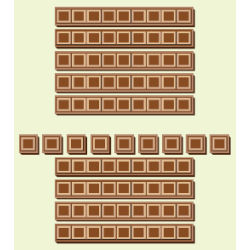
1. Charlie needs to break up chocolate bars in the process of baking s’mores for his children and their friends. Each bar is a rectangle scored into a five-by-nine array of squares. To break a bar into small squares, Charlie repeatedly picks up a single piece of chocolate and cracks it along a line (see Figure 1).
Charlie breaks up the first bar by first cracking it along its longest lines, resulting in five strips of nine squares each. He then dismantles each strip, square by square, for a total of 4 + 5 × 8 = 44 breaks. He breaks up the second bar the opposite way, first into eight strips of length five, then breaking up these strips for a total of 8 + 9 × 4 = 44 breaks, again. Darn. Can Charlie do better? What’s the smallest number of breaks Charlie needs to reduce a chocolate bar to its constituent squares?
2. Charlie’s children, Alice and Bobby, steal one of the bars and agree to play the following game: They place the bar on the table with its rows of nine squares aligned east-west (see Figure 2). Alice chooses any square and eats it, along with all the squares to the northeast (including straight north or east) of the chosen square. Bobby then chooses some remaining square and eats it, again along with all remaining squares to the northeast. The two then continue to alternate until the bar is completely gone.
Alice could have started with the square at the southwest corner of the bar and thus consumed the whole bar in her first turn. But that square happens to be rotten. The object of the game is to force your opponent to eat the last square.
Prove that Alice indeed has a winning strategy.
3. What strategies enable Alice to win the game on any rectangular chocolate bar with more than a single square of chocolate?





Join the Discussion (0)
Become a Member or Sign In to Post a Comment